Back in the January of 1997, I traveled to the island of Grenada with my mother. In the 1960s, after he had officially retired from his post in Trinidad, her father, the Reverend James MacDonald had served the Presbyterian congregation on Grenada for a few years – and had helped found a secondary school on the north end of the island. The current pastor had wanted to celebrate the 30 years of the school’s existence and had invited Mom and my cousin Janet to attend. Mom didn’t want to travel by herself (being elderly) and so treated me to the trip.
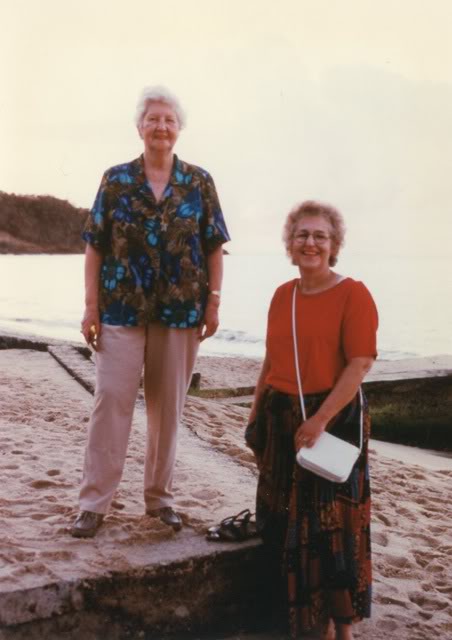
Mom and Janet
Perhaps it was the connection of the family history to the island, but I really enjoyed the visit. We were there five days. Unlike many other places, Grenada (at that time, and I don’t think it has changed much) was not so high on tourist destinations. It is certainly not a wealthy island. But it has its charms.
I’ve been thinking lately of places I would like to go – if time and money were not considerations. And Grenada is one of those places. It’s a low key place, that I could enjoy at leisure. Sitting on a patio, writing. Maybe explore the island more than we had a chance to do during that short visit.
To get to Grenada, we changed planes in Puerto Rico. The approach to the one commercial airport on the island is over the ocean water. The plane comes in low over the waves, because the runway is so short, the plane has to start braking as soon as all wheels are down. This landing strip was one of the issues contributing to the US invasion of the island – the Cubans had been invited to construct the new landing strip, and Reagan believed it was intended for military purposes. After the invasion, the Americans finished the strip: the island did need it. But it’s a sort of breath-taking landing all the same.
We stayed at a hotel at the south end of the sweep of the beautiful Grand Anse Beach. This is on the Caribbean side of the island, where the waters are calmer and enticing. The Atlantic side has more aggressive waves – but I didn’t have much chance to see a lot of that part of the island. Another reason to go back.
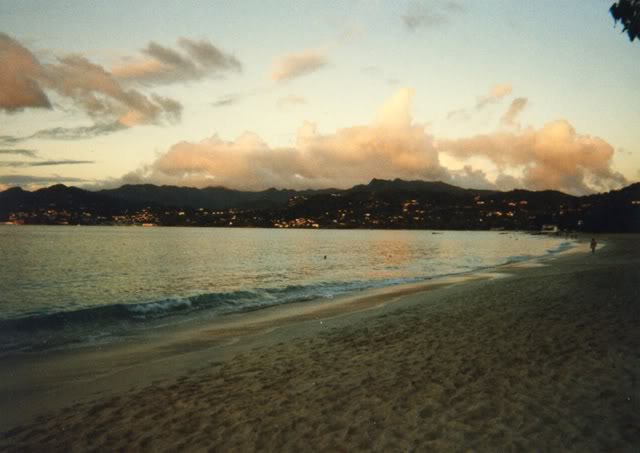
Grand Anse Beach
As you can see, it’s like stepping into a postcard.
According to a 2005 estimate, the island’s population is about 110,000. That’s not a lot of people for a Nation. I’ve attended the San Diego Comic Con for about 10 years now, and last year’s attendence was 125,000 people. It’s a sobering perspective: this tiny island nation has fewer people to make its life happen (farming, marketing, educating, running businesses) than show up in the city of San Diego for five days each summer, crammed into an expansive convention center.
It’s tiny. The capital of St. George’s crowds around the narrow harbor, on steep slopes.
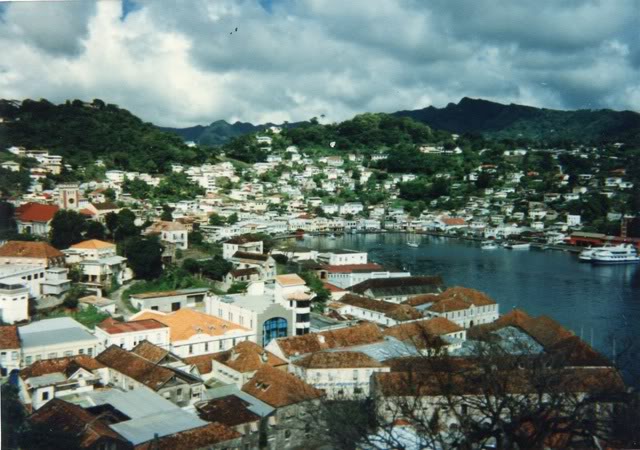
St. George’s, Grenada
In driving into the town, we went past a couple of schools with well groomed playing fields. Cricket playing fields. Soccer (excuse me, “football”) fields I expected. But the people of Greneda love cricket.
I expect that things have changed to a certain degree since our visit. The island has certainly courted more tourism. In 2007, Grenada was a joint-host with other islands of the World Cricket Match – in a stadium financed by the People’s Republic of China. That’s a little bit of information that doesn’t surprise me. When we drove up to the north end of the island during our visit, we passed a number of construction projects – small things by American standards, but infrastructure building, none the less – that had signs indicating that the projects were financed by … yes, the People’s Republic of China. I looked at the signs and shook my head at the blindness of American foreign policy.
But let’s not get into that topic. I’m waxing nostalgic here, about a place that left its fingerprints on my heart. I don’t know why that is so. It’s such a small place, I wonder how they manage to thrive. Growing spices is their primary industry (although courting tourism has grown, I understand). And because there are so many spices – nutmeg leading the way – cooking is also a big thing. That’s another thing I’d like to get to know better. The food was wonderful.
We drove up to the north end of the island to visit the school named after my grandfather. There’s something really inspiring in seeing the results of an action one of your near forefathers took. Those students were bright and eager to pursue the opportunities their education might make for them. Again, I was struck by the vastly different perspective from what I knew in America. These children considered themselves very fortunate to be able to continue schooling beyond an elementary level. For some of them there was likely to be the opportunity to go off to college somewhere, and perhaps even find a life elsewhere.
When we were driving back down the east side of the island after visiting the school, we stopped in the town of Grenville for dinner. This was on a week day, and we ended up being the only customers for dinner. The seafood was fresh and wonderfully cooked. And because we were the only customers, we got into conversation with our waiter.
It turns out, he was the cousin of the owner (and cook) of the restaurant and was helping his relative out. He was actually college educated, having gone to university in Toronto. He’d gotten a law degree, but returned to the island. He told us that most of the young people who manage to leave the island for school never come back. Given how poor the island is, I could understand that, but the fact that he had chosen to return impressed me. He did have a law practice, and had served in the island Parliament (although I don’t think he was a member at that time). There was a certain strangeness to that idea: a well educated, well-spoken man with a law degree and service in his nation’s Parliament was helping out his cousin by waiting tables in a seafood restaurant. He lost no dignity or face in waiting tables. To me, he seemed even more remarkable for doing so. He spoke so eloquently about his concern for the brain-drain of all those young Grenadians leaving and what that was doing to the future of his home.
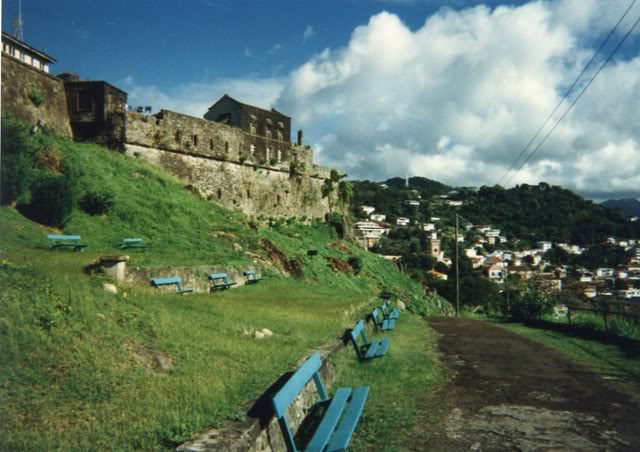
The Fort
Perhaps it is that intimacy of the island that captured my affection. It is so small that everything counts. There is no great distance between the person who brings you your dinner in a restaurant and someone involved in the governance of the country. That smallness of space has nurtured a friendliness that was refreshing to this visitor. And it’s a slower pace of life. You can’t rush on the island, it’s just not possible. It’s very mountainous, so you can’t drive fast. Even though the island is only 26 miles long, it took us over two hours to drive from St. George’s on the south end up to Sauteurs at the north end. Narrow, twisty roads going up and down mountainsides just do not make for fast travel.
So, yeah. I would like to go back some day. I’d make myself a “writer’s retreat” and enjoy the more quiet pace of the island life. I’d sit on one of the benches at the Fort, overlooking the harbor and watch the tourist cruise ships come in, watch the tourists make their quick excursions into the local shops, and then watch the ships sail out again. After which, I’d go to some small restaurant and enjoy a spice-laden dinner of island cooking, while listening to a small local calypso band.
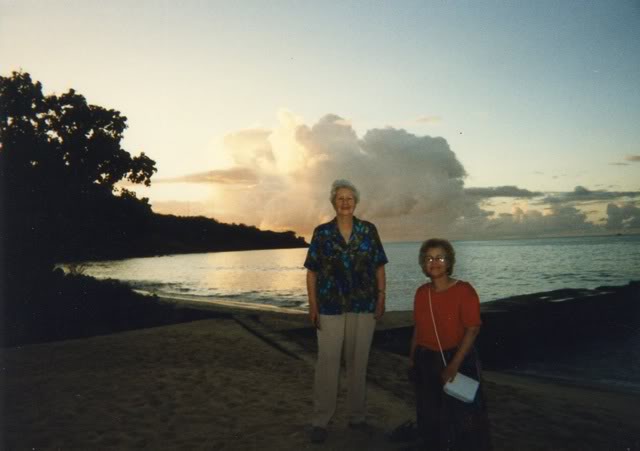
My mother and cousin at sunset.
And always, in the back of my mind, there will be the memory of my mother enjoying our visit.


